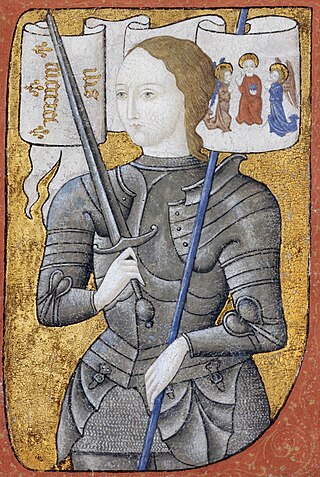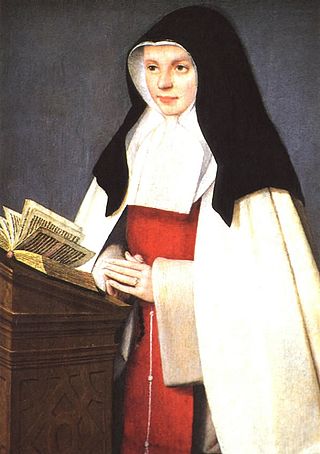Related Research Articles

Joan of Arc is a patron saint of France, honored as a defender of the French nation for her role in the siege of Orléans and her insistence on the coronation of Charles VII of France during the Hundred Years' War. Claiming to be acting under divine guidance, she became a military leader who transcended gender roles and gained recognition as a savior of France.

The siege of Orléans marked a turning point of the Hundred Years' War between France and England. The siege took place at the pinnacle of English power during the later stages of the war, but was repulsed by French forces inspired by the arrival of Joan of Arc. The French would then regain the initiative in the conflict and began to recapture territories previously occupied by the English.

Charles VI, nicknamed the Beloved and later the Mad, was King of France from 1380 until his death in 1422. He is known for his mental illness and psychotic episodes that plagued him throughout his life.

Philip III was Duke of Burgundy from 1419 until his death. He was a member of a cadet line of the Valois dynasty, to which all 15th-century kings of France belonged. During his reign, the Burgundian State reached the apex of its prosperity and prestige, and became a leading centre of the arts.

Alain Chartier was a French poet and political writer.

Joan of France, was briefly Queen of France as wife of King Louis XII, in between the death of her brother, King Charles VIII, and the annulment of her marriage. After that, she retired to her domain, where she soon founded the monastic Order of the Annunciation of the Blessed Virgin Mary, where she served as abbess. From this Order later sprang the religious congregation of the Apostolic Sisters of the Annunciation, founded in 1787 to teach the children of the poor. She was canonized on 28 May 1950.

John II of Alençon was a French nobleman. He succeeded his father as Duke of Alençon and Count of Perche as a minor in 1415, after the latter's death at the Battle of Agincourt. He is best known as a general in the Last Phase of the Hundred Years' War and for his role as a comrade-in-arms of Joan of Arc.

Georges de la Trémoille was Count of Guînes from 1398 to 1446 and Grand Chamberlain of France to King Charles VII of France. He sought reconciliation between Philip, Duke of Burgundy and Charles VII during their estrangement in the latter part of the Hundred Years' War. De la Trémoille was a political opponent of Arthur de Richemont within the French court. Most historians take a poor view of his career, assessing that he placed personal advancement before the public interest, though the traditional historical interpretation of the Grand Chamberlain as Jeanne d'Arc's opponent has been revised.

The Battle of Jargeau took place on 11–12 June 1429. It was part of the Loire Campaign during the Hundred Years' War, where the forces of Charles VII of France successfully recaptured much of the region, following their victory at the Siege of Orléans. The battle ended in victory for Charles VII and is notable as Joan of Arc's first offensive battle.
Jean Bréhal OP was the inquisitor-general of France who led the effort to rehabilitate Joan of Arc.

Due to inconsistent record keeping and different contemporary customs, the name of Joan of Arc at birth is not known for certain.

Jean d'Aulon (1390–1458) was a French knight and lord best known for serving alongside Jeanne d'Arc as her soldier, steward, bodyguard, and squire. Some sources incorrectly attribute the role of d'Arc's bodyguard to Gilles de Rais. d'Aulon was an avid and detailed journaler and his records, considered to be honest and straightforward, set the foundation for what we know about Jeanne d'Arc, including her apparent amenorrhea.

The Battle of La Brossinière or Battle of la Gravelle was a battle of the Hundred Years' War on 26 September 1423. It occurred at La Brossinière, between the forces of England and France, shortly after hostilities had resumed, following the battle of Agincourt (1415).

Rouen Castle was a fortified ducal and royal residence in the city of Rouen, capital of the duchy of Normandy, now in France. With the exception of the tower wrongly associated with Joan of Arc, which was restored by Viollet-le-Duc, the castle was destroyed at the end of the 16th century, its stones quarried for other construction.

The conviction of Joan of Arc in 1431 was posthumously investigated on appeal in the 1450s by Inquisitor-General Jean Bréhal at the request of Joan's surviving family – her mother Isabelle Romée and two of her brothers, Jean and Pierre. The appeal was authorized by Pope Callixtus III.
Guillaume Cousinot de Montreuil (1400–1484) was a French diplomat, magistrate and civil servant. He served as France's diplomatic representative in England between 1444 and 1449, during a period of truce between the two countries. Apart from his diplomat occupation, he was also a poet and historian.

Jeanne de Clisson (1300–1359), also known as Jeanne de Belleville and the Lioness of Brittany, was a French / Breton former noblewoman who became a privateer to avenge her husband after he was executed for treason by the French King Philip VI. She crossed the English Channel targeting French ships and often slaughtering their crew. It was her practice to leave at least one sailor alive to carry her message of vengeance.
Joan the Maid is a 1994 French historical film directed by Jacques Rivette. Chronicling the life of Joan of Arc from the French perspective, it was released in two parts: Joan the Maid, Part 1: The Battles and Joan the Maid, Part 2: The Prisons.

After the French lifted the siege of Orléans and won a decisive victory at the Battle of Patay, the English and Burgundians no longer posed a threat. Joan of Arc convinced the Dauphin Charles to go to Reims for his coronation. Successfully marching their army though the heart of territory held by the hostile Burgundians solidified the Dauphin’s regrasp of the throne of France. He had been disinherited from it through the Treaty of Troyes.

Auguste Vallet de Viriville, after 1858 known as Auguste Vallet was a French archivist and historian.
References
- ↑ Hillman, Richard (2005). "The Tragic Channel-Crossings of George Chapman Part II: The Revenge of Bussy D'Ambois, the Tragedy of Chabot". Cahiers Élisabéthains. 67 (1): 23–31. doi:10.7227/CE.67.1.4. ISSN 0184-7678. S2CID 163419332.
- ↑ Arn, Mary-Jo (2000). Charles D'Orléans in England. Boydell & Brewer. ISBN 978-0-85991-580-9.
- ↑ Ste Jeanne D'Arc website
- ↑ Nouvelle Biographie Générale . Librairie Renouard.
- ↑ Ste Jeanne D'Arc website
- ↑ Brill Online website, Encyclopedia of the Medieval Chronicle